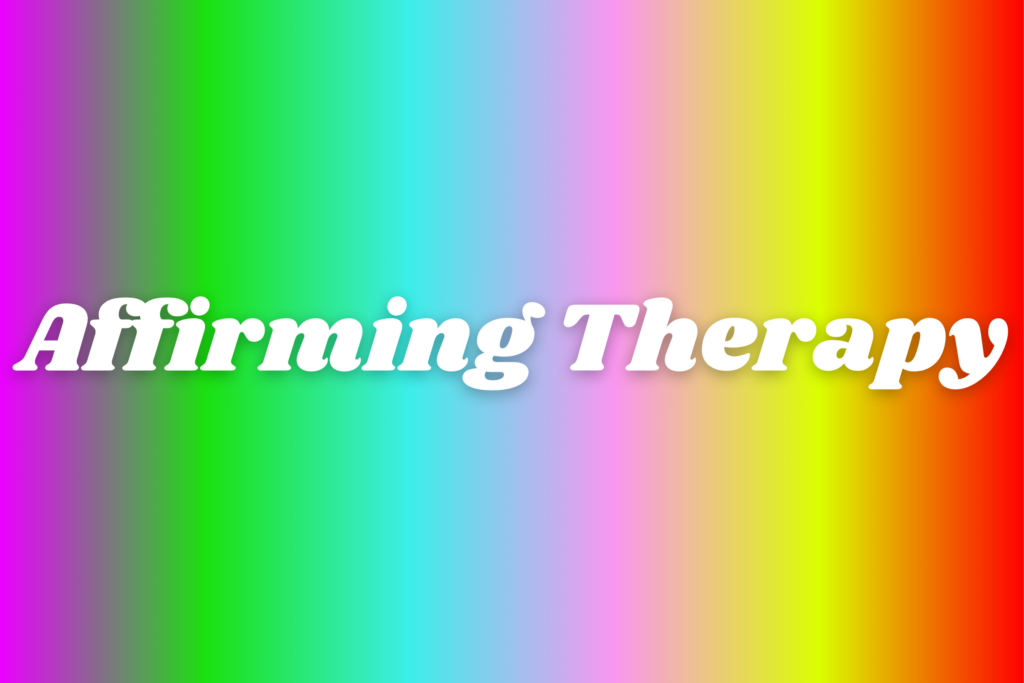 The Need for Affirming Care
The Need for Affirming Care
It’s hard enough to ask for help — harder still when you’re not sure you’ll be safe once you do.
For LGBTQ+ individuals, the fear that a therapist might not “get it” isn’t hypothetical — it’s often rooted in lived experience. A 2023 study found that LGBTQ+ people are over 2.5 times more likely to experience anxiety, depression, substance misuse, and suicidal ideation than their heterosexual and cisgender peers. Despite this clear need for mental health support, many LGBTQ+ folks hesitate to reach out — and understandably so.
Even in therapy, harm can happen. Sometimes it looks like subtle microaggressions; other times, it’s more overt — invalidation, pathologizing, or outright discrimination. That’s why finding an affirming therapist isn’t just helpful — it’s essential. At our practice, we believe in creating safer, inclusive, and empowering spaces for LGBTQ+ individuals to heal and grow. Here’s how to start navigating that journey.
What Makes a Therapist “Affirming”?
There’s no single credential or license that makes a therapist “affirming.” Anyone can check a box on a directory, but that doesn’t guarantee safety or understanding. So how can you tell if a therapist is genuinely LGBTQ+ affirming?
Here are some green flags to look for:
- They use inclusive language from the start — asking pronouns, avoiding assumptions, and validating identity without question.
- They’ve had training or lived experience in LGBTQ+ mental health — not just a diversity workshop once in grad school.
- They understand the difference between gender, sex, and sexuality and don’t conflate or pathologize any of them.
- They practice cultural humility — meaning they stay open to learning and repair, even when they get it wrong.
- They offer trauma-informed, non-pathologizing care, and they don’t treat identity as something to “fix.”
Affirming therapy doesn’t mean your therapist is perfect. But it does mean they’re actively working to support you with care, curiosity, and respect.
Where to Start Looking: Directories and Resources
If you’re ready to start looking, online directories can be a great first step. While they’re not foolproof, many include filters for LGBTQ+ identity, training, and lived experience.
- Online directories:
- TherapyDen – specifically allows LGBTQ+ filtering
- Inclusive Therapists – prioritizes intersectional and culturally competent providers
- Psychology Today – use filters like “LGBTQ+ Affirming” and read bios carefully
- National Queer and Trans Therapists of Color Network (NQTTCN) – dedicated to healing for QTBIPOC folks
You can also check with:
- Local LGBTQ+ centers or community orgs
- College/university counseling centers
- Word-of-mouth from friends or mutuals you trust
Sometimes the best referrals come from people who’ve already done the work of finding someone affirming.
Questions to Ask: Interviewing a Potential Therapist
A therapist is supposed to work with you — and you’re allowed to ask questions before deciding whether to move forward. Whether it’s a free consultation or the first session, here are a few questions that can help you gauge whether someone is affirming:
- “What experience do you have working with LGBTQ+ clients?”
- “How do you approach gender, sexuality, and identity in your work?”
- “What do you do to stay accountable to anti-oppressive or anti-bias practices?”
- “If you make a mistake (like misgendering), how do you typically handle it?”
You’re allowed to listen to your gut. If something feels off, you don’t owe anyone your continued time or trust. Finding the right fit may take a few tries — that’s okay. You’re worth the effort.
Barriers and Realities: Navigating Cost, Safety, and Location
Even when you’ve found a therapist who seems like the right fit, the reality is that many LGBTQ+ individuals still face significant barriers to care. One of the most common is financial. With many private and group practices not accepting insurance, therapy can feel out of reach. While some therapists offer sliding scale options or work in community-based clinics, that may limit your choices or mean you can’t see the therapist you feel most connected to. Cost shouldn’t be a barrier to healing — but unfortunately, for many, it still is.
Location can be another challenge, especially for those living in conservative or rural areas. Because therapists are generally limited by state licensure laws, your geographic region can seriously impact your ability to find affirming care. In areas where inclusive therapists are few and far between, you may feel like you’re choosing between staying closeted or going without support. The rise of teletherapy has helped to expand access, allowing people to connect with affirming providers from anywhere — but it doesn’t erase the emotional weight of that isolation.
Then there’s the emotional toll of even beginning the search. For many LGBTQ+ folks, seeking help brings up a host of fears — the fear of being judged, misunderstood, or even harmed. There’s often a deep weariness that comes from past experiences of being pathologized, dismissed, or forced to educate others about your identity in spaces that were supposed to be healing. Therapy should be a space where you can unpack — not one where you have to defend or explain yourself just to be seen.
These barriers are real, and they are valid. But so is your right to care. Affirming therapy may take a little more time to find, but it does exist — and it’s worth holding out for.
What Affirming Therapy Can Look Like
Affirming therapy isn’t just about a therapist who knows the right terminology — it’s about having a space where your full self is welcomed, supported, and celebrated. When therapy is truly affirming, it can be a place to unpack gender dysphoria or embrace the joy of gender euphoria. It’s a space where you’re allowed to explore your identity at your own pace — whether that means finding a label that feels right or deciding that you don’t need one at all.
For many, affirming care offers an opportunity to process painful family dynamics and begin the hard but necessary work of setting boundaries. It can also be a place to grieve losses that others might not understand — estrangement, rejection, or the experience of growing up unseen. At the same time, it can be where you start to build something new: a sense of belonging, the concept of chosen family, and the confidence to seek out a community that loves you as you are.
Therapy might also help you untangle internalized shame — especially for those navigating religious trauma or growing up in environments where your identity wasn’t just ignored, but actively erased. Through affirming care, clients often begin to rewrite those narratives. You learn to take up space again, emotionally and physically. You begin to feel the difference between surviving and living.
There is no single way affirming therapy looks — because every LGBTQ+ person brings a unique story, history, and need to the work. But at its core, affirming care creates the conditions for healing to actually happen: safety, respect, and the freedom to show up without shrinking.
You Deserve This Support
If you’re queer, trans, questioning, or anywhere on the LGBTQ+ spectrum — you deserve care that sees you, respects you, and celebrates you.
You deserve a therapist who doesn’t just tolerate your identity but welcomes it. Someone who won’t require you to shrink, translate, or overexplain. Someone who is still learning (because we all are) — but knows how to learn without causing harm.
And when you’re ready, we’re here.
At Peaceful Way, our therapists are not only LGBTQ+ affirming — they’re committed to doing the ongoing work of creating safer, braver, and more inclusive spaces. Whether you’re just beginning to explore therapy or are ready to jump in, we’re here to support you.
Take the first step:
Schedule a free 15-minute consultation. Let’s find someone who truly fits.

